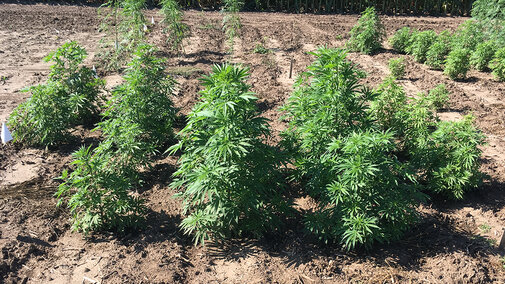University of Nebraska-Lincoln Extension information typically is based on the interpretation of research information from Nebraska or elsewhere in the Midwest. However, such information is not available for hemp production due to previous restrictions on research in the U.S. This publication relies heavily on research findings from Europe and Canada and learning from growers’ experiences. See more stories in this series at https://cropwatch.unl.edu/tags/hemp.
CBD Demand
Demand for CBD, a non-psychoactive compound derived from hemp, has soared for un-validated treatment of many conditions and illnesses. However, an approximate 75% plummet in prices for the CBD feedstock during 2019 indicates that the supply exceeded demand.
CBD-containing products marketed in the US range from cosmetics to chocolate bars to bottled water to pet treats, all with no regulation. The Food and Drug Administration warned marketers of CBD products against the use of non-validated health claims to sell their products. In June 2019 the FDA approved the first CBD-based drug, called Epidiolex, to treat seizures caused by extreme types of epilepsy. The efficacy of CBD for treatment of chronic pain, neuro-inflammation, anxiety, addiction, and anti-psychotic effects has not been well-validated by clinical research.
Hemp grown for CBD is a high-value crop grown more as a horticultural than as an agronomic crop. It has a high labor demand, putting US production at a disadvantage with production in China and other countries with relatively inexpensive labor.
Hemp CBD varieties have not been well-validated for Nebraska but possibilities may include ‘Abocus’, ‘Autopilot’, ‘Boax’, Cherry Wine, Cherry Blossom, Cobbler, and Sweetgrass for high pharmaceutical-grade CBD yield but having less than 0.3% THC.. High CBD varieties are generally grown only as female plants, as the combination of male and female plants leads to seed production and decreased CBD yield. Breeders continue to improve the processes for creating stable feminized seed. Farmers need to be wary of the source of their feminized seed stock and to check test results for validation of feminized seed.
Farmers need to know state regulations for testing hemp for CBD and THC. The Nebraska Department of Agriculture (NDA) regulations for industrial hemp production have been approved by USDA. Plant sampling by NDA staff to test for THC needs to be within 15 days before the date of harvest with the grower present during sampling. If the THC level is >0.3% by dry weight, the crop will not meet the legal definition of industrial hemp and need to be destroyed. Again, THC is expected to increase with stressful growing conditions.
CBD varieties have short plants with much branching, growing as squat bushes. The suggested spacing at this time is 2-4 feet x 6 feet. Planting practices may change for higher plant densities when seed supply is sufficient to greatly reduce the cost of seed. Given the high cost of seed, seedlings should be produced in a greenhouse for transplanting. If planting more than five acres, machine transplanting is recommended which may allow transplanting 2 acres per day. Plants can also be produced from cuttings with similar vigor and productivity compared to plants from seedlings. Propagation from cuttings may improve plant uniformity and is a means to all-female plants. The potting mix for greenhouse production of seedlings is important but needs to be well-drained with good available water holding capacity and nutrient supply. The mix probably should include sandy loam soil, perlite, and some organic material.
The CBD levels can be much reduced by cross-pollination with wild or non-CBD hemp. The CBD plants must be well-separated by distance or time of pollination from hemp weeds or another hemp crop. Also, a few rows of corn or forage sorghum can planted around the plots to reduce pollen flow.
The highest concentration of CBD is in the bracts of female flowers but CBD oil may be extracted from the whole plant. Harvest may be by topping plants for the harvest of mostly leaves and flowers, by picking the leaves and flowers from the plant, or by taking most of the plant cut at 8-12” above the ground. The whole plant harvest may be by shredding such as with a silage chopper or by keeping the plant intact.
Drying the plant material is a major operation as the water content is high when harvested. To reduce the quantity to be dried and handled for CBD production, the woody stems may be removed for land application, composting or dried separately for fiber production. Artificial drying at up to 100 oF should be continuous flow but the temperature of the plant material should not exceed 75 oF. Suspending plants or branches upside down by wires indoors out of the sun and with good air movement for air drying at up to 75 oF is a common practice if the harvest is not too large.
The ground-up plant material is soaked in grain alcohol or ethanol to extract the CBD oil. After soaking, the mix is pressed to extract the liquid. The alcohol is then evaporated off leaving the CBD oil.
Drying for smoke able buds is an option. Smoking of CBD is reported to be more effective than oral consumption. The buds are preferred but some upper leaves may be included. Well-dried material can be kept and sold in sealable plastic bags or glass jars.
Market information is too weak for prediction or advice but information is improving such as with a USDA ERS Feb 2020 report.
For information on budgeting for hemp grain, fiber and CBD production, see worksheets from Pennsylvania State University and from the University of Kentucky.

